Abstract
This paper investigates carbon productivity (CP) from the perspectives of industrial development and urbanization to mitigate carbon emissions. We propose a hybrid model that includes a spatial lag model (SLM) and a fixed regional panel model using data from the 17 provinces in the central and western regions of China from 2000 to 2018. The results show that the slowly increasing CP has significant spatial spillover effects, with High–High (H–H) and Low–Low (L–L) spatial distributions in the central and western regions of China. In addition, industrial development and urbanization in the study area play different roles in CP, while economic urbanization and industrial fixed investment negatively affect CP, and population urbanization affects CP along a U-shape curve. Importantly, the results show that the patterns of industrial development and urbanization that influence CP are homogenous and mutually imitated in the 17 studied provinces. Furthermore, disparities in CP between regions are due to industrial workforce allocation (TL), but TL has been inefficient; industrial structure upgrades are slowly improving conditions. Therefore, the findings suggest that, in the short term, policymakers in China should implement industrial development policies that reduce carbon emissions in the western and central regions by focusing on improving industrial workforce allocation.
1. Introduction
Carbon emissions continue to increase driven by energy consumption increase from human activities, which is the most important factor in global warming and environmental degradation [1]. Carbon emission mitigation plays a vital role in ensuring the protection of the human living environment [2,3,4]. Since China has become the largest emitter of carbon emissions [5], the Chinese government has planned to achieve carbon neutrality by 2060. Enhancing carbon productivity (CP), the ratio of economic output to per-unit carbon emissions [6,7], has become a national strategy in China to build a low-carbon economy.
Industrial development plays a vital role in energy consumption. Thus, adjusting the industrial structure has always been a key measure to increase CP and create a low-carbon economy in China [8,9]. Adjusting the industrial structure consists of optimizing resource allocation and improving technological progress [10,11]. Consequently, CP increased greatly in China from 0.26 in 2000 to 0.49 in 2018, with an increase of 1.88 times, decreasing the growth rate of fossil energy consumption. However, due to large disparities in CP and economic growth patterns among regions in China, the total amount of carbon emissions had been increasing and reached 12.23 billion tons in 2018, which was much higher than that of other countries. In China, the eastern region is developed, while the central and western regions are less developed. Furthermore, disparities between the eastern region and the western and central regions have continuously increased over the past 20 years, even though the national government has implemented policies to promote industrial development in the western and central regions to reduce those imbalances. Such policies include the “Development of the Western Region in China” issued in 2000 and the “Rise of Central China” issued in 2006. In the face of rapid economic growth requirements, local governments in the western and central regions generally focus on rapid economic growth, increasing resource inputs (fixed investments) to heavy and capital-intensive industries. In consequence, the rapid economic growth, dependent on heavy chemical and resource-based industries (contributing to over 50% of the regional economic growth), has led to growing environmental problems [12]. Carbon emissions in the central and western regions of China increased to 5.72 billion tons in 2018, but CP in those regions only increased to 0.42, which was lower than the CP value of 0.63 in the eastern region, and the CP growth rate was slower than that in the eastern region, with resident disposable income per capita far lower than in the eastern region. Moreover, the central and western regions in China are important ecological reserves and natural resource reserve zones. Thus, it is essential to better understand the relationship between industrial development and carbon productivity to mitigate carbon emissions while still promoting economic development.
Cities have become hotspots of the global carbon cycle, with considerable fossil fuel CO2 emissions (http://www.globalcarbonatlas.org/en/content/global-cities-emissions, accessed on 15 June 2021). Thus, optimizing urbanization has also been regarded as an important measure to reduce carbon emissions [13]. Urbanization, as an indicator of socioeconomic modernization, not only represents population shifts from rural to urban areas, but also causes structural transformations in infrastructure and socioeconomic structure. China has been experiencing a dramatic shift to urban living along with industrial transformation and rapid economic growth. For example, the urban population in China increased from 17.92% in 1978 to 60.60% in 2019, and the average annual income of urban residents increased from CNY 388 to CNY 42,359 per capita (https://data.stats.gov.cn/easyquery.htm?cn=C01, accessed on 10 June 2021). However, the increasing urban population and better living conditions have brought significant impacts and challenges to natural resources and the environment [6]. In addition, in most Chinese provinces, growing industrial activities around and within cities have rapidly increased CO2 emissions. For example, in 2016, China’s cities accounted for about 85% of the total national energy consumption and generated over 85% of national carbon emissions [14]. Thus, the rapid economic development has also exacerbated environmental problems [15]. By 2018, the population urbanization rate had grown to 56.19% and 54.19%, respectively, in the less-developed central and western regions of China, but the resident disposable income per capita was only CNY 32,377 and CNY 33,596, respectively, far lower than the national average of CNY 43,090. Therefore, it is essential to explore trends in CP to mitigate carbon emissions from population growth and economic urbanization in the western and central regions of China.
A low-carbon economy and carbon neutrality mean increasing CP and thus reducing carbon emissions while maintaining rapid economic development. CP is an input–output relationship between material (energy) consumption and social wealth, which is inevitably affected by industrial development and urbanization. Moreover, interactions between regions have continuously increased along with growing economic and social mutual exchanges. Thus, spatial effects should be considered when studying regional environmental economic issues [16]. We use a spatial econometric model to investigate CP from the perspectives of industrial development and urbanization. Model results and analysis suggest scientific and specific policy proposals for improving CP and thus achieving carbon neutrality in the central and western regions of China.
The remainder of this article is organized as follows. The literature review is described in Section 2 and the methods and data are presented in Section 3. Section 4 provides the results and analysis, while the discussion is presented in Section 5. Finally, we draw conclusions and make policy suggestions in Section 6.
2. Literature Review
Carbon productivity (CP) is an indicator used to evaluate carbon emission performance, which has been globally adopted by policymakers and researchers [17]. Finding methods to promote industrial development that enhances CP while reducing carbon emissions has been the focus of academic environmental economics research [18]. Numerous studies have illustrated that the impacts of industrial development on CP are heterogeneous [19,20,21,22]. For example, Benjamin and Lin (2020) indicated that the growth of the metallurgical industry negatively affects CP [21]. Adesina (2020) demonstrated that CP in the concrete industry of Canada was inefficient and that extensive economic growth negatively affects CP [22]. In addition, many studies have proven that the impacts of industrial development on CP vary across regions [23,24]. For example, Zhu et al. (2021) identified that industrial development in the Yangtze River Delta of China is conducive to increased provincial CP [24], but Ullah et al. (2020) indicated that Pakistan’s industrial development cannot effectively increase CP [25].
The relationship between urbanization and CP has also been extensively investigated in recent decades based on different types of data and on national, city, and household-level models. However, the relationship between urbanization and CP is still controversial [26]. On one hand, many studies have indicated that urbanization is detrimental to CP due to increased energy consumption that accompanies urbanization [13,27,28]. For example, Liu et al. (2018) indicated urbanization in China had reduced CP in the emerging urban agglomerations [13]. Li and Wang (2019) verified that urbanization had led to a more energy-intensive lifestyle which decreased CP [27]. Some of these studies have been conducted within the framework of the environmental Kuznets curve (EKC) hypothesis [29]. As Martnez-Zarzoso and Maruotti (2011) verified, the relationship between urbanization and CP in developing countries shows an inverted U-shape, and now urbanization in those developing counties is still located in the stage that leads to CP decrease and increased carbon emissions [30]. On the other hand, numerous studies identified that urbanization positively improves CP and eases urban environmental problems [31,32]. Liobikienė and Butkus (2019) researched the relationship between urbanization and carbon emissions in 147 countries and found that urbanization had improved energy use efficiency, thereby promoting CP [33]. Wang et al. (2021) agree that Chinese urbanization has brought the centralized use of energy and technological progress and thus reduced carbon emissions while increasing CP [31].
Recently, many studies have demonstrated that CP varies by region, with spatial spillover effects [17,34,35]. Furthermore, most local governments in China generally prefer upgrading their industrial structures to reduce carbon emissions, but have failed to reach their goals [36]. It is, therefore, crucial to investigate the relationship between industrial development and CP as a method of achieving carbon neutrality since the provincial governments in China are the direct executive bodies in charge of emission reduction. In addition, the impact of urbanization on CP shows temporospatial differences. Sadorsky (2014) indicated that the impacts of urbanization on environmental pollution differ by resident income [37]. Hence, it is important to incorporate urbanization into the CP study to better understand the major factors of CP and their influencing mechanisms.
Based on the characteristics of CP, many scholars have used the LMDI decomposition approach, Tapio decoupling models, and spatial methods to study CP [18,19,20]. Recently, spatial methods have been more widely used to study the relationship between CP and its influencing factors. Since the selection of the spatial weight matrix has an important influence on spatial model results, spatial weight matrices mainly include three types: the adjacency matrix; the distance matrix; and the economic–geographical distance matrix [16]. In this study, we introduce the economic–geographical distance matrix to estimate spatial weight, more realistically identifying the spatial–economic relationship between regions.
This paper has the following contributions to the research on the correlations between industrial development and CP and between urbanization and CP. (1) This study introduces the gravity model to calculate the spatial weight matrix for spatial spillover effects. This method is similar to the method used by Lan et al. (2020) [20], but while that article focused on direct geographic and economic relationships between regions, their method ignored the spatial network relationship of carbon emissions. We use the gravity model to estimate the spatial weight index because it incorporates spatial network relationships and more realistically identifies the spatial–economic relationship between regions. (2) Departing from previous studies focused on the relationship between CP and industrial structure upgrades or between carbon productivity and urbanization [23,36], our article aims to investigate correlations between industrial development and CP and between urbanization and CP, revealing the spatial effects of industrial development and urbanization on CP.
3. Methods and Data
3.1. Study Area
In this study, the research area included the central and western regions of China (Figure 1). The Chinese central government has divided China’s regions into four economic–geographical zones based on levels of socioeconomic development, geographical location, and natural endowments and has accordingly implemented different policies across economic–geographical zones. The central region includes six provinces: Shanxi, Henan, Anhui, Hubei, Hunan, and Jiangxi; the western region includes 11 provinces (municipalities and autonomous regions): Inner Mongolia, Guangxi, Chongqing, Sichuan, Guizhou, Yunnan, Shaanxi, Gansu, Qinghai, Ningxia, and Xinjiang (Tibet is not included due to its unique geographical location and data availability).

Figure 1.
The four economic–geographical zones of China.
3.2. Variables
3.2.1. Carbon Productivity (CP)
CP is the ratio of economic output to per-unit carbon emissions [6,7]. An increase in CP means that more social wealth is generated with less material and energy consumption. CP has become one of the main quantitative indicators for the low-carbon economy to measure development quality, environmental law enforcement level, citizen and corporate environmental ethics, and environmental legal awareness of a country and region [4]. The calculation is shown in Formula (1):
where CPit is carbon productivity (CP) in region i and time t; Yit represents gross domestic production (GDP) in region i and time t; and Cit is the amount of carbon emissions in region i and time t.
In addition, we refer to the 2006 IPCC Guidelines to estimate carbon emissions. The 2006 IPCC Guidelines for National Greenhouse Gas (2006 IPCC Guidelines) provide a technically sound methodological basis for national greenhouse gas inventories. The calculation is shown in Formula (2):
where C is the amount of carbon dioxide emissions; k (k = 44/22), is the molecular weight ratio of carbon dioxide to carbon; Ej is the consumption of fossil fuel j; is the emission coefficient of fossil fuel j. The coefficient of CO2 emission of eight fossil fuels provided by the 2006 IPCC Guidelines for National Greenhouse Gas inventories is shown in Table 1.

Table 1.
Carbon emission coefficients of fossil fuels.
3.2.2. Industrial Development Level: TL, TK, TS
According to the economic production theory, industrial development can be described and measured in two dimensions: resource allocation and technological progress [38]. Resource allocation efficiency represents allocation efficiency of workforce and physical capital among industries in a region for a given amount of technological progress. In theory, a higher resource allocation efficiency means higher economic efficiency, while a lower resource allocation efficiency represents less efficient economic development.
First, workforce is a major factor in economic growth, and its allocation among industries in a region, to some extent, directly reflects the efficiency of resource allocation. According to Pareto improvement theory, the flow of workforce between industries in a certain area is a process of Pareto improvement and, to some extent, reflects that workforce allocation is inefficient and does not reach Pareto optimality [39]. That is to say, an industry with higher marginal output of workforce units always absorbs more workforce inflows from industries with lower marginal output of workforce units, until the output of per-unit workforce input in the three industry levels is equal. In other words, the workforce allocation reaches an optimal state or Pareto optimality when the flow of workforce reaches a relative equilibrium. In this study, we referred to the methods outlined by Zhou et al. (2013) to quantify the level of workforce allocation, with the equation expressed as Formula (3) [40]:
where TLit is the efficiency of workforce allocation of three industry levels in region i at time t; k = 1, 2, 3, the primary-, secondary-, and tertiary-level industries, respectively; Yit is the amount of outputs from industries in region i at time t; Yikt is the output from industry k in region i at time t; Lit is the quantity of employment by industries in region i at time t; Likt is the quantity of employment for industry in region at time . Y/L, workforce productivity; Ln, the natural logarithm. When , the workforce allocation efficiency is in equilibrium. This means that under the existing level of technological progress, when the level of resource allocation reaches the optimal level, the workforce allocation among the three industry levels is in a relatively balanced and static state, then . Therefore, lower means that resources are put to better use and produce better outcomes.
Second, to simplify analysis, we used fixed investments instead of physical capital inputs. Thus, in this study, the ratio of the gross product value to fixed investments (TK) was used to quantify physical capital productivity in industries. The equation is shown in Formula (4). Here, higher TK value means higher output efficiency of fixed investments.
where is the efficiency of utilizing fixed investments in region at time ; is the gross domestic product (GDP) in region at time ; is the investment in fixed assets in region at time .
Industrial structure upgrading, to some extent, represents technological progress of industries in a region, characterized by a shift in production factors from an industry with lower productivity to an industry with higher productivity. Here, we referred to the methods outlined by Moore (1978) and Liu et al. (2021) to quantify industrial structure upgrading. The equation can be expressed as Formula (5) [38,41]. This method is useful because measuring structural change based on the angle between the two vectors can be done very simply by using a linear algebra formula for the cosine of the angle between vectors.
where TS is the industrial structure upgrading level (the higher the TS, the higher the industrial structure upgrading level); , the proportion of production from industry to the GDP (gross domestic production); is a set of three-dimensional vectors: ; , three base vectors as ; , and ; , the intersection angle of vectors and . The vectors are then defined in the hierarchical order of each industry, and then the angle between each industry vector and the related base vector (, , ), is calculated.
Using the panel datasets from the 17 provinces in the central and western regions from 2000 to 2018 in Equations (3)–(5), the datasets of workforce allocation (TL), economic output efficiency of fixed investments (TK), and industrial structure upgrading (TS) were obtained.
3.2.3. Urbanization Level
Urbanization is a phenomenon of economic and social modernization. It is not only the process of transferring rural workforce from an agricultural economy to urban areas dominated by industry and services but also a process of structural transformation from rural areas to urban areas [42]. In this study, we used population and economic urbanization to quantify the urbanization level. Population urbanization is the process of population shift from rural areas to urban areas; economic urbanization refers to city development as a proxy of resident living style and living level. This paper uses the proportion of urban population in permanent residents to measure population urbanization and urban resident disposable income per capita to measure economic urbanization.
3.2.4. Data Sources and Processing
In this study, we used provincial-level panel data from 2000 to 2018 to estimate the relationship between industrial development and CP, and the relationship between urbanization and CP in the central and western regions of China. Social and economic datasets came from the China Statistical Yearbook (2000–2019) (http://www.stats.gov.cn/, accessed on 10 May 2021), the China Energy Statistical Yearbook (http://www.nea.gov.cn/, accessed on 10 May 2021), the Urban Statistical Yearbook (https://data.stats.gov.cn/easyquery.htm?cn=C01, accessed on 10 May 2021), the Provincial (city and autonomous region) Statistical Yearbooks (https://data.cnki.net/Yearbook/Navi?type=type&code=A, accessed on 10 May 2021), and the website of the National Bureau of Statistics (http://www.drcnet.com.cn/www/int/, accessed on 10 May 2021). All the original datasets were preprocessed to meet the requirements of calculation and model estimation, including the GDP added value, the added value of industrial output, the number of employees in primary, secondary, and tertiary industries, the total investment in fixed assets, permanent population at the end of the year, fossil energy consumption, etc. Consumer price index (CPI2000 = 100) was introduced to reflect real economic growth and eliminate nominal price impacts. All the data were processed using a smoothing logarithm before building the model to eliminate unit impacts (in order to ensure the variables had the same quantity level for meeting the model requirement, we preprocessed the original data for carbon productivity as follows: CP index = Ln(CP + 5)). In addition, all the variables passed the unit root and cointegration tests to ensure the stability of the data and prevent spurious regression. Table 2 presents the descriptive statistics of these variables.

Table 2.
Descriptive statistics of the variables.
3.3. Model Description
This section provides the summary of the basic definitions and concepts of the spatial econometric model theory. In this section, we first explain the spatial weight matrix calculation and the spatial autocorrelation model. Then, we describe the spatial econometric model.
3.3.1. Spatial Weight Matrix Calculation
The gravity model has been widely used to quantify the correlation of spatial socioeconomic networks between regions [43]. In this study, we improved the gravity model to implement the estimation of the spatial network relationship of CP and construct a spatial weight matrix as shown in Formula (6):
where are provinces and , respectively; is the spatial weight index of the carbon emission spatial network between provinces and ; is annual average number of permanent residents in provinces and during the study period, respectively; and are the annual average carbon emissions in provinces and during the study period, respectively; and are the annual average GDP values in provinces and during the study period, respectively; is the economic–geographical distance between provinces and ; is the geographical distance between provinces and ; is the annual average GDP per capita of provinces and during the study period, respectively. Then, using the datasets from 2000 to 2018, spatial weight indexes between the provinces in the form of a 17*17 matrix could be obtained.
3.3.2. Spatial Autocorrelation Model
Spatial autocorrelation refers to the correlation of a variable between areas to measure the aggregation degree of a spatial unit attribute [44]. There are two different scales for measuring regional spatial dependence: global spatial autocorrelation and local spatial autocorrelation. Global spatial autocorrelation describes the overall distribution of an observation and is used to determine whether the observation has agglomeration characteristics spatially, but it cannot precisely indicate where the observation is concentrated. Moran’s I is generally used to test global spatial autocorrelation as expressed in Formula (7). Local spatial autocorrelation is used to calculate the range of a spatial hot spot. A Moran scatterplot is generally used to test local spatial autocorrelation which can be expressed as Formula (8) [44].
where n is the number of provinces; and are provinces and ; are the values of the variable in the provinces and , respectively; is the average value of ; is the spatial weight index between provinces and ; is the variance of ; is the local Moran index in the unit. The value of Moran’s I is located between [−1, 1]; a higher Moran’s I value means stronger spatial dependence. When the Moran’s I value exceeds zero, there is a positive spatial correlation between spatial units, that is, a spillover effect is shown. When the index is less than zero, there is a negative spatial correlation between units, showing an agglomeration effect. When the index equals zero, spatial units are independent.
3.3.3. Spatial Econometric Model
The spatial econometric model improves model estimation and reveals spatial and temporal tendencies of the objects under study by combining their temporal and spatial distribution characteristics [44]. Figure 2 shows the schematic diagram of the spatial econometric model for CP. The general equation for calculating the spatial econometric model for CP is shown as Formula (9):
where and are regions and ; is time; Wir is the spatial weight matrix; is the explanatory variable; is the spatial lag term of the interpreted variable; is the spatial lag term of the explanatory variable; is the spatial regression coefficient of the interpreted variable; is the coefficient of the explanatory variable; is the coefficient of the lag term of the explanatory variable; is the coefficient of the spatial error; is the random interference term; is the random error item. In Formula (9), when , it is a spatial lag model (SLM); when and , it is the spatial error model (SEM); when , it is the spatial Durbin model (SDM).
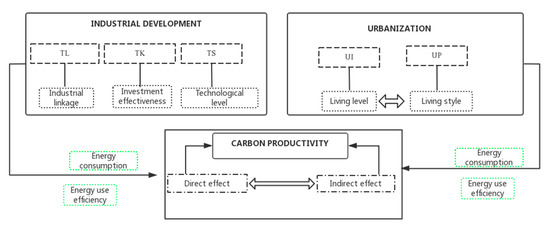
Figure 2.
Schematic diagram of the spatial econometric model for CP.
Based on the spatial autocorrelation test, we built the SLM and SEM models to determine which model is more suitable using the following steps.
Step 1: construct an SLM to determine whether CP is affected not only by local factors, but also by those factors from surrounding areas. The specific calculation can be expressed as Formula (10).
Step 2: construct an SEM to investigate whether the spatial correlation of error terms has spatial effects (i.e., impacts from the surrounding provinces’ error terms on the carbon emissions for the original province). The expression is shown in Formula (11).
Step 3: implement the LM (Lagrange multiplier) and R-LM (robust Lagrange multiplier) tests. These tests, including the LM spatial lag (LMLAG), robust LM spatial lag (R-LMALG), LM spatial error (LMERROR), and LM robust spatial error (R-LMERROR), are used to determine whether to build an SLM or SEM [44].
where is the carbon productivity of province at time ; is the spatial weight matrix; is the workforce allocation index of industries in region at time ; is the industrial structure upgrading index in region at time ; is the economic efficiency of fixed investments in region at time ; is the population urbanization rate in region at time ; is the economic urbanization level in region at time ; is the random interference term; is the random error item; is the spatial lag correlation coefficient (spatial CP spillover effect from the surrounding regions); is the spatial error correlation coefficient; is the individual (regional) difference.
4. Results and Analysis
4.1. Spatial Autocorrelation Test
Table 3 and Figure 3 show that mutual dependency between regions increased and that CP had positive spillover effects. First, all the significance tests for global Moran’s I regarding CP in the 17 provinces of the central and western regions of China passed the 5% significance level test during the study period of 2000–2018. Meanwhile, all the global Moran’s I values exceeded zero and continuously increased from 2009, and most of the 17 provinces in both 2000 and 2018 were located in the first and third quadrants of the figure which illustrates positive correlations between the provinces (Figure 3), exemplifying a positive spatial effect. In theory, a positive spillover effect means that CP within each province positively affects the CP of surrounding areas. The increasing Moran’s I shows that spatial agglomeration of CP between the provinces has continuously increased.

Table 3.
Global Moran’s I for carbon productivity (2000–2018).
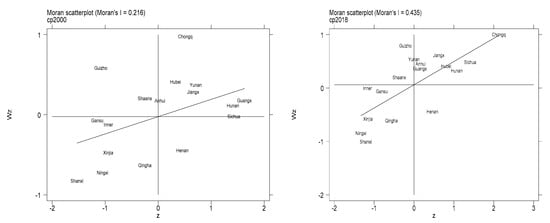
Figure 3.
Moran scatterplots of carbon productivity in the central and western regions (2000 and 2018).
4.2. Spatial Model Results
Model estimation results illustrate that the spatial lag model (SLM) can be chosen to estimate the spatial relationship between the variables (Table 4). First, all the tests for LMLAG, R-LMLAG, LMERROR, and R-LMERROR passed the 1% significance level. However, the LMLAG test showed more significance than the LMERROR test. The robust LM test results showed that R-LMLAG was more significant than R-LMERROR. Finally, the Hausman test results show that the fixed effects model is the most suitable to deal with these unobservable individual effects. In addition, the goodness of fit for the regional fixed effects SLM was , and all the estimated parameters passed the 5% significance test.

Table 4.
Model estimation results.
Based on the SLM, we could decompose the impacts of the explanatory variables on the explained variables into direct and indirect effects as shown in Table 5 [20,45]. Direct effects capture the sum of spatial feedback effects on the region of origin and traditional effects within the region of origin () while indirect effects represent the average value of interregional spillovers () [20,45].

Table 5.
Direct and indirect effects of the explanatory variables on CP in the SLM.
4.3. Carbon Productivity (CP)
The results show that carbon productivity (CP) in the 17 provinces of the central and western regions of China slowly increased during the period 2000–2018, characterized by obvious spatial differences (Figure 4 and Figure 5). Figure 4 displays that CP in the central and western regions of China increased from 0.22 and 0.21 in 2000 to 0.50 and 0.37 in 2018, i.e., 2.17 and 1.76 times, respectively, with CP values in the central region exceeding those in the western region. By contrast, lower CP, lower income, and higher carbon emissions simultaneously occurred in these two regions. First, CP was only 0.50 (in the central region) and 0.37 (in the western region) in 2018, far lower than the CP (0.63) in the eastern region of China. Meanwhile, the total amount of carbon emissions in the central and western regions rapidly increased from 0.87 billion tons in 2000 to 2.49 billion tons in 2018 in the central region and from 0.76 billion tons in 2000 to 3.23 billion tons in 2018 in the western region. However, the GDP index in 2018 was only 12.51 in the central region and 11.83 in the western region, far lower than the value of 60.12 in the eastern region.
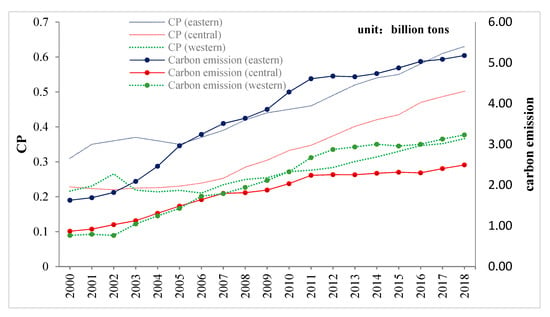
Figure 4.
Carbon emissions and carbon productivity in China, 2000–2018.
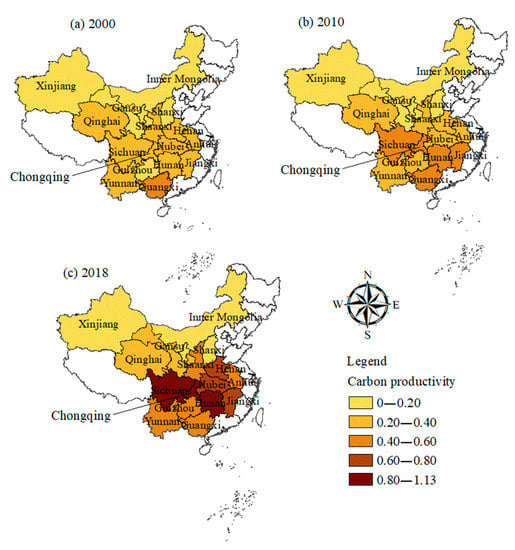
Figure 5.
Spatial distribution of carbon productivity by province. Note: (a), (b) and (c) are the spatial distribution of CP in 2000, 2010 and 2018, respectively.
Table 4 shows that CP has a significant spatial spillover effect in the 17 provinces of the central and western regions of China as the spatial correlation coefficient of CP () is 0.51. Meanwhile, the spatial CP distribution is characterized by High–High (H–H) and Low–Low (L–L) agglomeration (Figure 5). H–H agglomeration indicates that the province of origin with a higher CP induces higher CP in the surrounding provinces. In contrast, L–L agglomeration means that the province of origin with a lower CP induces lower CP in the surrounding areas.
Figure 5 shows that the spatial spillover effects of H–H and L–L agglomeration continuously increased during the period 2000–2018, which is consistent with the phenomena of increasing global Moran’s I (Table 3). For example, in the H–H agglomeration, CP in Guizhou was just 0.12 in 2000 and increased to 0.38 in 2018 (3.17 times). This effect is especially evident in Sichuan where CP increased from 0.19 in 2000 to 0.93 in 2018, with a rapid increase of 4.89 times, and in Hunan where CP increased from 0.29 in 2000 to 0.63 in 2018 (2.17 times). The L–L agglomeration includes the provinces of Shanxi and Anhui of the central region and Xinjiang, Ningxia, and Inner Mongolia of the western region. Especially in Inner Mongolia, CP was just 0.13 in 2000 and only 0.15 in 2018, with a slow increase of 1.15 times.
4.4. Industrial Development and Its Impacts on CP
4.4.1. Workforce Allocation (TL)
The results show that TL plays a significant role in the CP of a local province and its surrounding provinces (Table 4 and Table 5). The direct and indirect marginal effects of TL on CP are −0.111 and −0.105, respectively, which means that CP for the province of origin and the surrounding provinces would decrease 0.111% and 0.105% when the TL for the province of origin would increase by 1%. The total marginal effect is −0.219, illustrating that optimizing workforce allocation is an efficient method to increase CP and also reduce carbon emissions.
Figure 6 and Figure 7 show that most TL values were higher than China’s average level during the studied period, 2000–2018, characterized by obvious spatial differences between regions. First, the TL index value in the central region was lower than that in the western region which means that workforce allocation efficiency in the central region was better than that in the western region. Meanwhile, most TL indexes in the central and western regions were higher than the national average, which indicates inefficient workforce allocation in these two regions (Figure 6). Second, most provinces in these two regions simultaneously encountered the “increasing–decreasing–increasing–decreasing” evolution in TL during the study period (Figure 7). These results also prove that the total amount of carbon emissions rapidly grew during the study period.
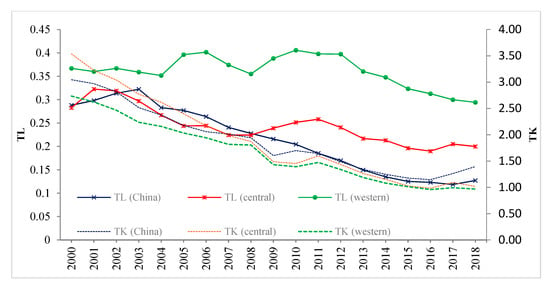
Figure 6.
Workforce allocation level (TL) and economic output efficiency of fixed investments (TK), 2000–2018.
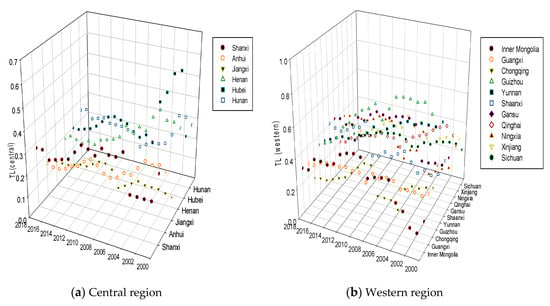
Figure 7.
Industrial workforce allocation (TL) of each province.
4.4.2. Economic Output Efficiency of Fixed Investments (TK)
The results show that TK plays an important role in CP (Table 4 and Table 5), with 0.01 of the direct and indirect effects. However, TK in the central and western regions during the study period decreased with similar trends, leading to a decrease in CP. Figure 6 and Figure 8 show that TK in these two regions continuously decreased during the study period, from 3.54 in 2000 to 1.02 in 2018 in the central region and from 2.37 in 2000 to 0.97 in 2018 in the western region. Importantly, decreased TK directly proves that previous fixed investments were excessive and negatively affected CP in the province of origin and the surrounding provinces. Secondly, TK disparities between those two regions were continuously decreasing and TK shows similar trends of change in the 17 provinces; this shows that TK is homogenous between provinces and reinforces identification of the agglomeration of H–H and L–L spatial distribution of CP (Figure 8). In addition, during the period 2000–2006, TK was higher in the central region than the national average level. Nonetheless, during the period 2007–2018, TK in the central region became lower than the national average. However, it is interesting to find that the Central People’s Government issued “Several Opinions of the Central Committee of the Communist Party of China and the State Council on Promoting the Rise of the Central Region” in 2006 to stimulate economic development in the central region.
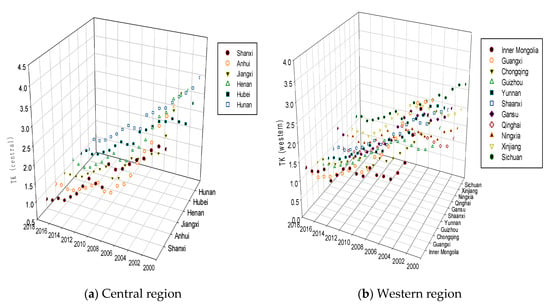
Figure 8.
Industrial economic efficiency of fixed investments (TK) of each province.
4.4.3. Industrial Structure Upgrading (TS)
Figure 9 shows that TS slowly increased from 6.13 in 2000 to 6.74 in 2018 in the central region and from 6.12 in 2000 to 6.68 in 2018 in the western region and was far lower than the national average. Importantly, Figure 9 and Figure 10 show that TS indices were characterized by the same change trends and increasing homogeneity between the provinces during the period 2000–2018. Especially in the central region, the homogeneity of TS between the provinces continuously increased. For example, the difference in TS between the Anhui and Shanxi provinces decreased from 0.52 in 2000 to 0.32 in 2018.
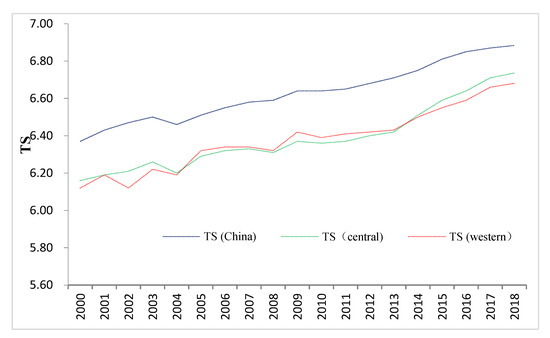
Figure 9.
Industrial structure upgrading (TS) of each province.
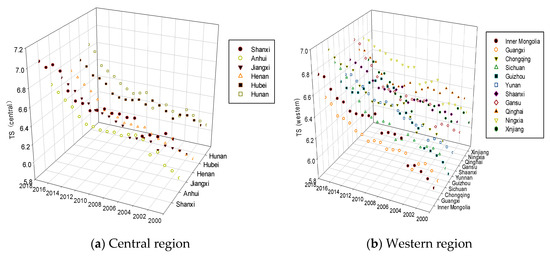
Figure 10.
Industrial structure upgrading index (TS) of each province.
The results show that TS plays a vital role in CP of a local province and its surrounding provinces (Table 4 and Table 5), with the direct and indirect effects of TS on CP of 0.099 and 0.094, respectively. This means the CP of a local province and its surrounding provinces would be improved by 0.099% and 0.094% when improving TS by one percent in the local province. Meanwhile, the Chinese government issued policies of the “coordinated development of the Yangtze River Economic Belt and the Yellow River Basin urban agglomeration” to improve coordinated development between the regions. With these policies, the spatial spillover effect of regional technological progress was continuously intensified to promote TS of the surrounding regions, which would lead to an increase in CP for the surrounding regions. Thus, industrial technology progress was homogenized between the provinces and mutually imitated, which is consistent with decreasing disparities in TS between the regions.
4.5. Urbanization Level and Its Impacts on CP
4.5.1. Population Urbanization (UP)
Results in Table 4 and Table 5 show that population urbanization (UP) plays an important role in CP. Population urbanization affects CP along a U-shaped curve (), changing with the UP level. In theory, CP first decreases with increasing UP before reaching the threshold point (i.e., when the population urbanization rate reaches 45.03%), and then increases with increasing UP.
Figure 11a,b illustrates that UP in the central and western regions continuously increased during the study period 2000–2018. Along with rapid economic growth, UP in the central and western regions of China continuously and quickly increased during the entire study period from 30.62% in 2000 to 56.19% in 2018 in the central region and from 30.42% in 2000 to 54.19% in 2018 in the western region. All the UP levels in the 17 provinces already exceeded the threshold point value of population urbanization (45.03%) which shows that population urbanization already evolved into a state of positively affecting CP. For example, in the central region, UP for Jiangxi and Henan exceeded the threshold point by 2011 and 2014, respectively. However, in the western region, there was a large difference. In Inner Mongolia, UP exceeded the threshold point value by 2003, but in Qinghai, UP exceeded the threshold point value in 2017.
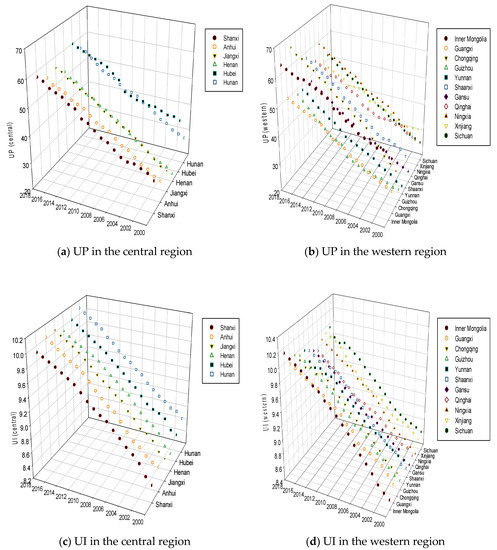
Figure 11.
Population (UP) and economic urbanization (UI) of each province.
4.5.2. Urban Resident Disposable Income (UI)
The model estimation results show that UI negatively affected CP linearly (direct and indirect effects are fixed), which also illustrates that the patterns of UI influencing CP were homogenous. Meanwhile, the direct and indirect effects of UI on CP were −0.043 and −0.041, which means that the CP of a local province and its surrounding provinces would reduce by 0.043% and 0.041% when UI would improve by one percent. This certifies that at the current stage of China’s development, increasing resident income or improving living levels leads to an increase in energy consumption in the studied regions, which further reflects that energy consumption is mainly from fossil fuels. For example, in 2019, the overall proportion of clean energy consumption to the total amount of energy consumption was only 23.4% in China.
Figure 11c,d shows that UI increased rapidly during the period 2000–2018 in the 17 provinces, all with the same change trend. Meanwhile, the evolutionary trajectories of UI between the 17 provinces were similar to some extent, which proves that the patterns of improvement in urban resident living levels were homogeneous in those two regions. Nonetheless, the values for UI in the central and western regions were far lower than China’s national average level. For example, all the values for UI in the 17 provinces ranged from 8.46 to 8.75 in 2000, and in 2018, ranged from 9.14 to 10.14, while China’s national average level was 8.75 in 2000 and 10.17 in 2018. In fact, those two regions simultaneously face the ongoing challenge of increasing UI and increasing CP. Increasing UI leads to increasing energy consumption due to living conditions improvements. In addition, most energy consumption relies on fossil fuels. Thus, increasing UI increases carbon emissions and decreases CP at the current stage of China’s development.
5. Discussion
Constructing a weight matrix of carbon productivity relationships based on the gravity model, we propose a hybrid model merging a spatial lag model and a fixed regional panel model to investigate the impacts of industrial development and urbanization on CP and its spatial spillover effects. Our results verify that industrial development and urbanization play vital roles in CP and that CP has obvious spatial spillover effects. Importantly, our findings certify that patterns of industrial development and urbanization between the provinces are homogenous. Furthermore, our findings indicate that the levels of industrial workforce allocation show obvious disparities between the central and western regions. Other factors including TK, TS, UI, and UP in those two regions evolved to the same values. Thus, the following discussion will focus on what caused these phenomena.
5.1. TL, TK, TS, and CP
Our results identified that TL, TK, and TS in the western and central regions play different roles in CP from the perspective of industrial development. First, the results identified that TL and TS made a higher contribution to dynamic changes in CP than TK. Second, the observations indicate that the intensity of marginal effects of TS on CP is lower than those of TL (Table 5), reflecting that improving TL is more effective than improving TS to enhance CP for carbon emission mitigation in the central and western regions of China. These findings show some differences from the results of Liu et al. (2020) and Zhang et al. (2021) [46,47], who identified upgrading the industrial structure as the most important and effective measure to promote CP for carbon emission mitigation. In fact, both TS and TL slowly improved while TK continuously decreased during the period 2000–2018 in these two regions. In particular, most provinces in those two regions experienced deterioration with regard to TL. To some extent, this mainly resulted from the fact that the central and western regions are less developed and thus the workforce of higher education levels generally outflowed from these two regions to more developed regions, which also increased disparities in the workforce between the regions. For example, the average number of years of education for the permanent population in the eastern, central, and western regions was 9.11, 8.15, and 7.92 in 2002, respectively, but reached 11.27, 10.05, and 9.69 in 2018.
Low CP and low economic development simultaneously occurred in the central and western regions (Figure 6, Figure 7, Figure 8, Figure 9 and Figure 10). The slowly increasing CP in the central and western regions, in part, relied on local government behaviors since the local governments in those regions generally preferred upgrading the industrial structure by undertaking industries transferred from more developed regions, which adjusts the industrial structure. Thus, in these two regions, increasing fixed investments and decreasing TK occurred simultaneously. As Sun and Huang (2020) clarified, the more highly developed regions tend to quickly promote CP by importing high-carbon products from less developed regions or by transferring their high-pollution industries to less developed regions [28]. For example, in 2006, the Central People’s Government issued “Several Opinions of the Central Committee of the Communist Party of China and the State Council on Promoting the Rise of the Central Region” to urge economic development in the central region by adjusting the industrial structure. In response, in 2006, fixed investments in the central region increased by CNY 1807 billion, with 27.08% of the highest growth rate during the period 2000–2006. It is interesting to note that TK in the central region has been lower than the national average level since 2006. As Wu et al. (2018) showed, local governments are the policy executors, and their behaviors are affected by their self-interests when implementing policies enacted by the Central People’s Government [48].
Similarly, our observations identify that fixed investments negatively affected CP, which was similar to the findings of Li and Qi (2011), who clarified that fixed investments exert a negative impact on the economic efficiency of industrial fixed investments [49]. The results were also consistent with the continuous decrease in TK in the central and western regions during the entire study period. Numerous studies have shown that the energy consumption structure influences carbon emissions directly as carbon content varies across energy sources. China’s energy consumption is highly dependent on fossil fuels, especially coal with the highest carbon content [27]. In fact, the industrial sectors that rely heavily on coal for production are generally resource-based, requiring heavy-chemical industries with high fixed investments. Zhang and Feng (2019) pointed out that resource-based and capital-intensive industries play an important role in economic growth in the central and western regions [50]. Compared with the eastern region, economic growth in the central and western regions could still lead to a decrease in CP or a rapid increase in carbon emissions if the proportion of CO2-dominating industries (like traditional heavy-chemical and resource-based industries) would not be diminished.
Finally, we found that CP has significant spatial spillover effects, with High–High (H–H) and Low–Low (L–L) spatial distributions in the central and western regions of China. The estimation results also show that industrial development has significant spatial spillover effects on CP, especially TL and TS, with indirect effects reaching 1.105 and 0.094. This result is in line with Lan’s results (2021), who demonstrated that agglomeration and imitation of interregional industrial sectors are beneficial to knowledge spillovers and communication of technological innovation that would probably lead to a reduction in the energy consumption difference between regions [20]. We found that due to the imitation effect of industrial development in the central and western regions, mutual communication and coordination, and increasing technology spillovers, industrial development is conducive to improving CP of the adjacent regions.
5.2. UI, UP, and CP
The model estimation results show that UI negatively affected CP, and UP negatively affected CP before UP reached the threshold point value, and then it positively affected CP. First, the results identify that increasing UI leads to an increase in energy consumption and then induces more carbon emissions. Second, findings verify that all the provinces experienced that increasing UP led to decreasing CP, and all the provinces evolved into a state of positively affecting CP by 2017. In addition, the marginal effects of UP on CP change with UP level. These results agree with the findings of Liu et al. (2018), who indicated that the impacts of population urbanization on CP differed between population urbanization levels [13]. In the central and western regions, the economic development and living levels show a large difference between rural and urban areas. For example, the difference in the resident disposable income per capita between urban and rural areas continuously increased from CNY 7549 in 2013 to 8480 in 2018 in the central region and from CNY 8041 in 2013 to CNY 9021 in 2018 in the western region. As Holtedahl and Joutz (2004) identified, population urbanization would increase energy consumption since population urbanization also increases resident access to electricity. Thus, energy consumption increases after people move to urban areas from both use of the existing electric appliances and after the purchase of new items. However, this finding reflects that energy consumption was mainly from fossil fuels, while there was a shortage of clean energy in the central and western regions during the study period. In China, the proportion of clean energy consumption to the total amount of energy consumption just reached 23%. Thus, increasing energy consumption in the central and western regions would lead to a decrease in CP. Increasing energy consumption is a major challenge to the goal of carbon neutrality. Second, the results identify that increasing population urbanization increases CP and reduces carbon emissions when the urbanization level reaches or exceeds the threshold point, which is in line with the findings of Wang et al. (2021), who posit that population urbanization improves the efficient use of public infrastructure and decreases energy use while enhancing CP [31].
6. Conclusions and Policy Suggestions
In this study, we proposed a hybrid model integrating an SLM and a fixed coefficient panel model to investigate CP, which accounts for carbon emission mitigation from industrial development and urbanization in the less developed central and western regions of China. Our model results show that CP has significant spatial spillover effects, with the characteristics of H–H and L–L spatial distributions. In addition, the results show that industrial development (TL, TK, and TS) and urbanization levels (UP and UI) play important, yet differing roles in the evolution of CP in the central and western regions of China. Meanwhile, our findings also show that industrial development and urbanization were homogenous and mutually imitated in the 17 provinces of the central and western regions.
The results provided here also are relevant to better understand the increasing challenges of carbon emission mitigation and carbon neutrality and the homogenized aspects of industrial development and urbanization in the studied regions. Further, our results illustrate that improving TL in the central and western regions of China at this stage is more effective than promoting TS and TK. Meanwhile, fixed investments were excessive, while industrial workforce allocation was inefficient. These findings clarify that local governments in the central and western regions should pay more attention to TL when implementing policies that adjust the industrial structure. At the current stage of China’s development, UP and UI increase fossil energy consumption, thereby increasing carbon emissions and reducing CP.
Based on the conclusions above, some policy suggestions can be put forward. (1) In terms of improving industrial development, Chinese local governments should focus on the long-term effects of transferring industries from the developed regions and not simply imitate the industrial development seen in the more developed regions. In addition, to improve TL efficiency in the central and western regions, local governments should introduce policies to attract top-level talent and encourage the migration of talented residents. (2) In view of the spatial spillover effect, it is necessary to strengthen regional communication and coordination, and the impact on the adjacent regions should be fully considered when governments at each level formulate industrial policies and environmental policies.
Meanwhile, in our model experiment analysis, we set only TL, TK, and TS of the industrial development instead of the complex industrial development including regionalization, industrial incentive policies, and resource endowments to simplify analysis. Thus, further work based on our proposed model should test a more general industrial development to investigate whether local resource endowments and regionalization inherently affect CP. Another possible direction for future research is into incentive efficiency of industrial policies on CP in different districts to test if the incentive effects of industrial incentive policies on CP will change along with incentive contents and regions.
Author Contributions
Conceptualization, Y.W. and H.Z.; Methodology, H.Z.; Software, H.Z.; Investigation, Y.W. and Y.L.; Resources, Y.W. and Y.L.; Data curation, H.Z.; Writing—original draft preparation, Y.W. and H.Z.; Writing—review and editing, Y.W., C.O.D. and Y.L.; Data collection, J.Q. All authors have read and agreed to the published version of the manuscript.
Funding
This work was supported by Projects of the National Natural Science Foundation of China (grant No. 41761112, 41771182) and the Key Research Institute of Philosophies and Social Sciences in Guangxi Universities (grant No. 19ZD003).
Institutional Review Board Statement
Not applicable.
Informed Consent Statement
Not applicable.
Data Availability Statement
Social and economic datasets came from the China Statistical Yearbook (2000–2019) (http://www.stats.gov.cn/, accessed on 10 May 2021), the China Energy Statistical Yearbook (http://www.nea.gov.cn/, accessed on 10 May 2021), the Urban Statistical Yearbook (https://data.stats.gov.cn/easyquery.htm?cn=C01, accessed on 10 May 2021), the Provincial (city and autonomous region) Statistical Yearbooks (https://data.cnki.net/Yearbook/Navi?type=type&code=A, accessed on 10 May 2021), and the website of the National Bureau of Statistics (http://www.drcnet.com.cn/www/int/, accessed on 10 May 2021).
Acknowledgments
In this research, we are grateful for the assistance of anonymous reviewers and the editors for their invaluable comments to improve this paper.
Conflicts of Interest
The authors declare no conflict of interest.
References
- U.S. Energy Information Administration (EIA). International Energy Outlook 2019 with Projections to 2050; Energy Information Administration: Washington, DC, USA, 2019.
- Dong, K.; Dong, X.; Jiang, Q. How renewable energy consumption lower global CO2 emissions? Evidence from countries with different income levels. World Econ. 2020, 43, 1665–1698. [Google Scholar] [CrossRef]
- Zhao, J.; Jiang, Q.; Dong, X.; Dong, K. Assessing energy poverty and its effect on CO2 emissions: The case of China. Energy Econ. 2021, 97, 105191. [Google Scholar] [CrossRef]
- Khan, Z.; Murshed, M.; Dong, K.; Yang, S. The roles of export diversification and composite country risks in carbon emissions abatement: Evidence from the signatories of the regional comprehensive economic partnership agreement. Appl. Econ. 2021, 53, 4769–4787. [Google Scholar] [CrossRef]
- Wang, X.; Tang, X.; Zhang, B.; McLellan, B.C.; Lv, Y. Provincial Carbon Emissions Reduction Allocation Plan in China Based on Consumption Perspective. Sustainabity 2018, 10, 1342. [Google Scholar] [CrossRef] [Green Version]
- Kaya, Y.; Yokobori, K. Environment, Energy and Economy: Strategies for Sustainability; Bookwell Publications: New Delhi, India, 1999. [Google Scholar]
- Report, M. The Carbon Productivity Challenge: Curbing Climate Change and Sustaining Economic Growth; Mckinsey Global Institute: Sydney, Australia, 2008. [Google Scholar]
- Yu, S.; Zheng, S.; Li, X.; Li, L. China can peak its energy-related carbon emissions before 2025: Evidence from industry restructuring. Energy Econ. 2018, 73, 91–107. [Google Scholar] [CrossRef]
- Wang, W.; Li, M.; Zhang, M. Study on the changes of the decoupling indicator between energy-related CO2 emission and GDP in China. Energy 2017, 128, 11–18. [Google Scholar] [CrossRef]
- Luan, B.; Zou, H.; Chen, S.; Huang, J. The effect of industrial structure adjustment on China’s energy intensity: Evidence from linear and nonlinear analysis. Energy 2021, 218, 119517. [Google Scholar] [CrossRef]
- Zhang, L.; Zhou, P. A non-compensatory composite indicator approach to assessing low-carbon performance. Eur. J. Oper. Res. 2018, 270, 352–361. [Google Scholar] [CrossRef]
- Lin, B.; Du, K. Energy and CO2 emissions performance in China’s regional economies: Do market-oriented reforms matter? Energy Policy 2015, 78, 113–124. [Google Scholar] [CrossRef] [Green Version]
- Liu, B.; Tian, C.; Li, Y.; Song, H.; Ma, Z. Research on the effects of urbanization on carbon emissions efficiency of urban agglomerations in China. J. Clean. Prod. 2018, 197, 1374–1381. [Google Scholar] [CrossRef]
- Li, W.; Wang, L. The First “Sketch” of Urban Energy Development in China (Translated from Mandarin). China Energy News, 22 October 2018. [Google Scholar]
- Chen, M.; Gong, Y.; Lu, D.; Ye, C. Build a people-oriented urbanization: China’s new-type urbanization dream and Anhui model. Land Use Policy 2019, 80, 1–9. [Google Scholar] [CrossRef]
- Anselin, L. Spatial Effects in Econometric Practice in Environmental and Resource Economics. Am. J. Agric. Econ. 2001, 83, 705–710. [Google Scholar] [CrossRef]
- Tian, K.; Dietzenbacher, E.; Yan, B.; Duan, Y. Upgrading or downgrading: China’s regional carbon emission intensity evolution and its determinants. Energy Econ. 2020, 91, 104891. [Google Scholar] [CrossRef]
- Zheng, X.; Wang, R.; Du, Q. How does industrial restructuring influence carbon emissions: City-level evidence from China. J. Environ. Manag. 2020, 276, 111093. [Google Scholar] [CrossRef]
- Wang, G.; Deng, X.; Wang, J.; Zhang, F.; Liang, S. Carbon productivity in China: A spatial panel data analysis. China Econ. Rev. 2019, 56, 78–89. [Google Scholar] [CrossRef]
- Lan, F.; Sun, L.; Pu, W. Research on the influence of manufacturing agglomeration modes on regional carbon emission and spatial effect in China. Econ. Model. 2021, 96, 346–352. [Google Scholar] [CrossRef]
- Benjamin, N.I.; Lin, B. Quantile analysis of carbon emissions in China metallurgy industry. J. Clean. Prod. 2020, 243, 118534. [Google Scholar] [CrossRef]
- Adesina, A. Recent advances in the concrete industry to reduce its carbon dioxide emissions. Environ. Chall. 2020, 1, 100004. [Google Scholar] [CrossRef]
- Cheng, Z.; Li, L.; Liu, J. Industrial structure, technical progress and carbon intensity in China’s provinces. Renew. Sustain. Energy Rev. 2018, 81, 2935–2946. [Google Scholar] [CrossRef]
- Zhu, B.; Zhang, T. The impact of cross-region industrial structure optimization on economy, carbon emissions and energy consumption: A case of the Yangtze River Delta. Sci. Total. Environ. 2021, 778, 146089. [Google Scholar] [CrossRef]
- Ullah, S.; Ozturk, I.; Usman, A.; Majeed, M.T.; Akhtar, P. On the asymmetric effects of premature deindustrialization on CO2 emissions: Evidence from Pakistan. Environ. Sci. Pollut. Res. 2020, 27, 13692–13702. [Google Scholar] [CrossRef]
- Muhammad, S.; Long, X.; Salman, M.; Dauda, L. Effect of urbanization and international trade on CO2 emissions across 65 belt and road initiative countries. Energy 2020, 196, 117102. [Google Scholar] [CrossRef]
- Li, S.; Wang, S. Examining the effects of socioeconomic development on China’s carbon productivity: A panel data analysis. Sci. Total Environ. 2019, 659, 681–690. [Google Scholar] [CrossRef] [PubMed]
- Sun, W.; Huang, C. How does urbanization affect carbon emission efficiency? Evidence from China. J. Clean. Prod. 2020, 272, 122828. [Google Scholar] [CrossRef]
- Zhou, C.; Wang, S.; Wang, J. Examining the influences of urbanization on carbon dioxide emissions in the Yangtze River Delta, China: Kuznets curve relationship. Sci. Total. Environ. 2019, 675, 472–482. [Google Scholar] [CrossRef] [PubMed]
- Martínez-Zarzoso, I.; Maruotti, A. The effect of urbanization on CO2 emissions: Evidence from developing countries. Ecol. Econ. 2011, 70, 1344–1353. [Google Scholar] [CrossRef] [Green Version]
- Wang, W.-Z.; Liu, L.-C.; Liao, H.; Wei, Y.-M. Impacts of urbanization on carbon emissions: An empirical analysis from OECD countries. Energy Policy 2021, 151, 112171. [Google Scholar] [CrossRef]
- Chen, S.; Li, N.; Guan, J. Research on statistical methodology to investigate energy consumption in public buildings sector in China. Energy Convers. Manag. 2008, 49, 2152–2159. [Google Scholar] [CrossRef]
- Liobikiene, G.; Butkus, M. Scale, composition, and technique effects through which the economic growth, foreign direct investment, urbanization, and trade affect greenhouse gas emissions. Renew. Energy 2019, 132, 1310–1322. [Google Scholar] [CrossRef]
- Cai, B.; Guo, H.; Ma, Z.; Wang, Z.; Dhakal, S.; Cao, L. Benchmarking carbon emissions efficiency in Chinese cities: A comparative study based on high-resolution gridded data. Appl. Energy 2019, 242, 994–1009. [Google Scholar] [CrossRef]
- Wang, K.; Wu, M.; Sun, Y.; Shi, X.; Sun, A.; Zhang, P. Resource abundance, industrial structure, and regional carbon emissions efficiency in China. Resour. Policy 2019, 60, 203–214. [Google Scholar] [CrossRef]
- Zheng, H.; Gao, X.; Sun, Q.; Han, X.; Wang, Z. The impact of regional industrial structure differences on carbon emission differences in China: An evolutionary perspective. J. Clean. Prod. 2020, 257, 120506. [Google Scholar] [CrossRef]
- Sadorsky, P. The effect of urbanization on CO2 emissions in emerging economies. Energy Econ. 2014, 41, 147–153. [Google Scholar] [CrossRef]
- Liu, J.; Hou, X.; Wang, Z.; Shen, Y. Study the effect of industrial structure optimization on urban land-use efficiency in China. Land Use Policy 2021, 105, 105390. [Google Scholar] [CrossRef]
- Varian, H.R. Intermediate Microeconomics: A Modern Approach; W.W. Norton & Company: New York, NY, USA, 1999. [Google Scholar]
- Zhou, X.; Zhang, J.; Li, J. Industrial structural transformation and carbon dioxide emissions in China. Energy Policy 2013, 57, 43–51. [Google Scholar] [CrossRef]
- Moore, J.H. A Measure of Structural Change in Output. Rev. Income Wealth 1978, 24, 105–118. [Google Scholar] [CrossRef]
- Poumanyvong, P.; Kaneko, S. Does urbanization lead to less energy use and lower CO2 emissions? A cross-country analysis. Ecol. Econ. 2010, 70, 434–444. [Google Scholar] [CrossRef]
- Yang, G.; Wu, Q.; Tu, Y. Researchs of China’s regional carbon emission spatial correlation and its determinants:based on the method of social network analysis. J. Bus. Econ. 2016, 4, 56–68. [Google Scholar]
- Anselin, L. Spatial Econometrics: Methods and Models; Springer: Amsterdam, The Netherlands, 1988. [Google Scholar]
- LeSage, J.; Pace, K.R. Introduction to Spatial Econometrics; Chapman and Hall/CRC: London, UK, 2009. [Google Scholar]
- Liu, Y.; Wang, M.; Feng, C. Inequalities of China’s regional low-carbon development. J. Environ. Manag. 2020, 274, 111042. [Google Scholar] [CrossRef] [PubMed]
- Zhang, S.; Kharrazi, A.; Yu, Y.; Ren, H.; Hong, L.; Ma, T. What causes spatial carbon inequality? Evidence from China’s Yangtze River economic Belt. Ecol. Indic. 2021, 121, 107129. [Google Scholar] [CrossRef]
- Wu, Y.; Dong, S.; Huang, H.; Zhai, J.; Li, Y.; Huang, D. Quantifying urban land expansion dynamics through improved land management institution model: Application in Ningxia-Inner Mongolia, China. Land Use Policy 2018, 78, 386–396. [Google Scholar] [CrossRef]
- Li, L.; Qi, P. The impact of China’s investment increase in fixed assets on ecological environment: An empirical analysis. Energy Procedia 2011, 5, 501–507. [Google Scholar] [CrossRef] [Green Version]
- Zhang, W.; Feng, P. Differentiation research of CO2 emissions from energy consumption and their influencing mechanism on the industrial enterprises above designated size in Chinese industrial cities: Based on geographical detector method. Nat. Hazards 2020, 102, 645–658. [Google Scholar] [CrossRef] [Green Version]
Publisher’s Note: MDPI stays neutral with regard to jurisdictional claims in published maps and institutional affiliations. |
© 2021 by the authors. Licensee MDPI, Basel, Switzerland. This article is an open access article distributed under the terms and conditions of the Creative Commons Attribution (CC BY) license (https://creativecommons.org/licenses/by/4.0/).